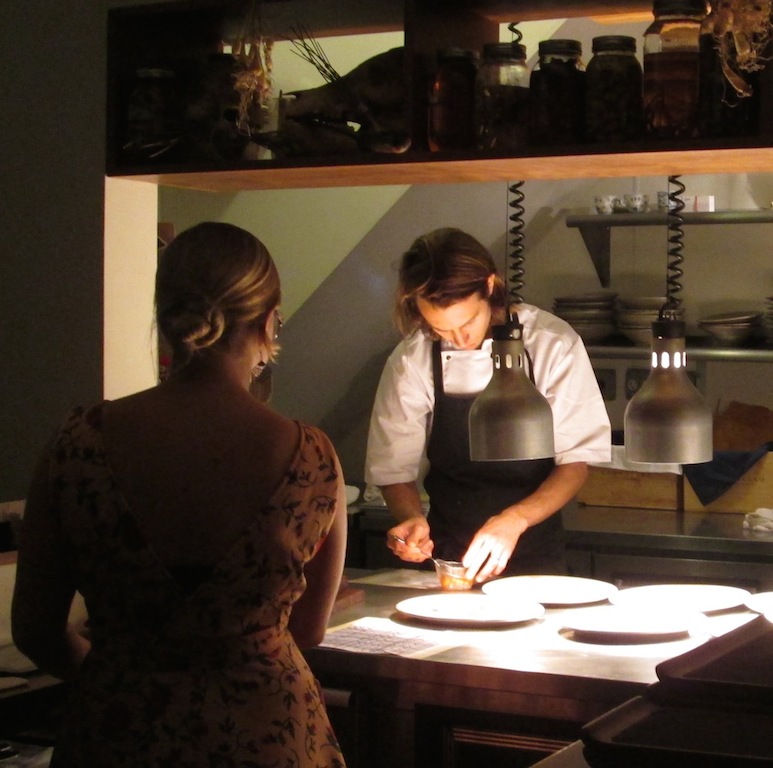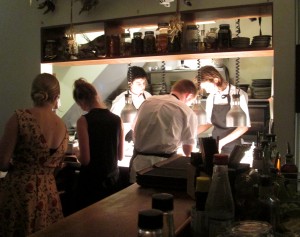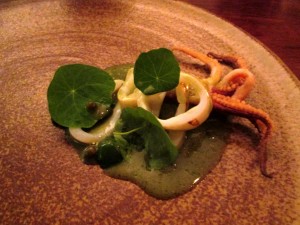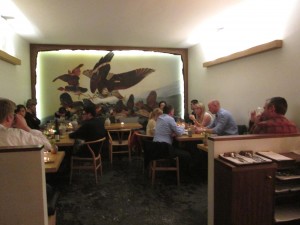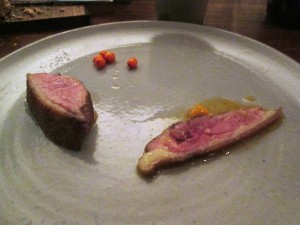(by Corbo Eng)
He has the look: thin, angular, and moody (a look, quite frankly, that could have graced a hundred ads or, if fate had taken a different course, might have cast him as a runway model, for sure, proudly sporting Michael Kors’ latest fall lineup but, also, that could have easily allowed him to be the front man for a band). Equipped with a microphone and, perhaps, strutting shyly but confidently, he could have famously sung about women, love, and sex. But, as fate would have it, Fredrik Berselius—destined to make an impact—is a star anyways. It’s just that he’s a chef.
Conceding that others with less culinary talent can grace the catwalks and stalk the concert stages in his place, there’s no doubt that, on any given night at Aska (Berselius’ Michelin-starred Brooklyn restaurant), the diners, lucky enough to have secured one of the eighteen seats in its exclusive dining room, would have wanted it any other way. To dine there and to indulge in Chef Berselius’ elegant tasting menu is to engage the present moment—a moment, now, where “New Nordic Cuisine,” bolstered by international attention and adoring accolades, is trending with the force of a whirling Scandinavian snowfall and that has recruited Berselius, on this side of the pond, as one of its leading men.
To see him on this night, as well, is to, indeed, see his leading—at least, in the microcosm of his kitchen where, with dinner service well underway, the trending moment has been spotlighted and reduced to a finite space (literally, at the vacant rectangle that serves as the partition between Aska’s tiny kitchen and the dining room beyond it). There, under heat lamps, Berselius and his sous chefs hover over rows of earthenware plates (or bowls, depending on the present course) like a surgical team might hover over a patient. With head bent down toward his food and spoon in hand—and with a scoop of puréed sauce left to drizzle, his next move may not be a matter of life or death; but, with artistic calculation rather than surgical precision, something, nonetheless, is at stake.
Of course, there is. It’s a well-known fact that a painter, holding his palette and brush, can deliberate as long as patience will allow until, suddenly, in one motion, he applies a final streak of color onto his waiting canvas at an exact spot—between two abstract shapes or at the end of a brilliant, indecipherable pattern—and declares it ready for consumption. While Fredrik Berselius isn’t holding a paintbrush or standing before an easel, it’s a common process. A splotch of mussel-and-seaweed emulsion, a piece of duck breast, or a strand of wistful wood sorrel is simply the stand-in. The art is the same.
Berselius, actually, toyed with the idea of becoming an architect, a graphic designer, or an illustrator at points in the past; and, so, his eye for composition and visual design has been part of his make-up. “I like to pick things apart,‚Äù he has said‚Äîreferring to a time, early in his career, when he was assigned the unenviable task of prepping the spinach at Per Se. From this period, one can see the signs of deconstruction in his cooking, the innate desire to create something from seemingly disparate parts, the inclination to take as well as assemble, and to pluck the Earth itself. If for nothing else, Berselius has become well-known as a forager in his rise to prominence. His ties to New Nordic Cuisine and its associations with foraging, notwithstanding, Berselius embraces this connection to nature.
Be it pea flowers, thistle, sumac, or garlic mustard leaves—having them freshly picked and unadulterated on the plate may take diners vicariously to the idyllic meadows and forests from where Berselius sources them and to remind them of how and why these ingredients are part of their meal in the first place. There’s no need to utter many words or to inject too much theory into it. Berselius is, at heart, someone who is a product of where he came from and the culture of its food. It is common, for example, for Swedish families to forage together, to pick wild berries when they are in season (and for those berries to accompany that evening’s meal)—just as some families here might seek out ice cream from a truck or stroll the aisles of a shopping mall to look for summer fashions.
In fact, his food memories, like those involving berry picking, are vital to his role as a chef. Berselius, as Aska’s chief spokesman, is fond of explaining that its food is based on the memories of his childhood and the flavor profiles that have left their imprint on him. As such, it is safe to say that his work at Aska is a very personal affair—not only for the artistry involved—and, the way, invariably, that all such endeavors tap into one’s soul, but for the way it draws from the places he’s left behind, his childhood, and how, using the past, his cooking pushes itself toward the future. Really, food memories at Aska don’t manifest themselves as classic Swedish or Scandinavian dishes with Berselius’ own versions of them ready for the taking. There is no gravlax, pickled herring, or are there IKEA style meatballs anywhere. Memories are merely the ghosts that wade through the foam, emulsions, and sauces, or that occupy the juxtapositions of protein and herbs and even the moonscaped pockmarks on the handmade plates. Memories give soul to new food.
Back in the dining room, with the night wearing on, everything seems new. Drawn from imagination and, often, strikingly original, there is little that makes each course known. It’s not unlike viewing art work and seeing nothing concretely represented other than beauty and emotion. Sometimes, that’s enough—sometimes, not. In either case, Berselius himself or one of his sous chefs (or even the reservationist if one is sitting at the bar) will personally walk out from the kitchen and serve the guests as it is done at Noma in Copenhagen—where, likewise, there is no wait staff as such. At that moment, the one serving the food, usually with a proud demeanor—and looking down at what is usually a medley of earth tones, unfamiliar shapes, and mysterious garnishes—will briefly explain: “This is skate wing with cauliflower and dill purée” or “salsify, lichen curls, and egg yolk.”
The menu, as would be expected, is seasonal and is “new” again in several months time when what’s foraged or what’s sold at the Greenmarket changes. Berselius visits the Greenmarket, usually the one at Union Square in Manhattan, preferably twice a week, where he scouts out what’s fresh and available and what sparks his interest. Looking ahead, he may even find inspiration for a dish or the perfect complement to some fresh venison or squid that he’s obtained. Now, with summer having segued into autumn and with the leaves in the trees having turned red, amber, brown, and orange, Aska’s menu itself may be changing too. Guests, desiring to return, often ask Berselius when he will offer a new tasting menu for them to try. The humble chef, without being coy, often just doesn’t know. When I inquire, Berselius—saying, “hi, nice to see you again”—looks a bit nonplussed and unsure. I don’t blame him. Art doesn’t follow a schedule.
Overhead, the night‚Äôs selection of music, which easily fills the dining room, sounds like something that also harks back to the past. It‚Äôs made up of brassy horns, melodic undertones, and feels metallic and reedy with that thin, taut drumming and tight production style that defined the mid-Sixties and that has been revived by recent acts. In between courses and having a good time, I want to call it “Swedish Motown” for lack of a better description. Chef Berselius, in his kitchen, looking over the prep table, this time, has a pair of tweezers in hand and is dressing lumps of milk sorbet with fresh yarrow. The music spends its energy as the last course is served. Dinner, like a resonating voice, lingers on. Tomorrow, it will be fondly recalled.
Copyright 2013 (Corbo Eng). All Rights Reserved.
All photos by Corbo Eng.
(This article was originally posted in October 2013)

